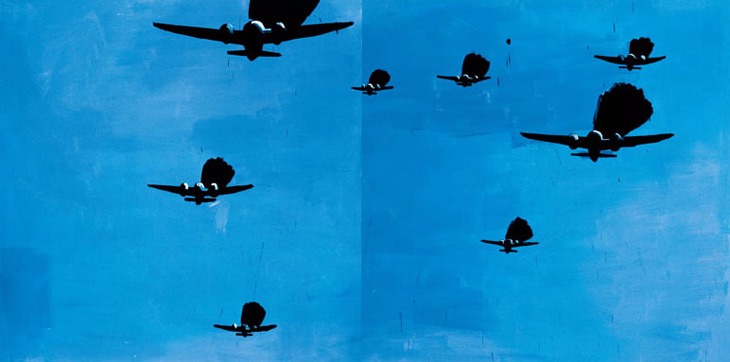
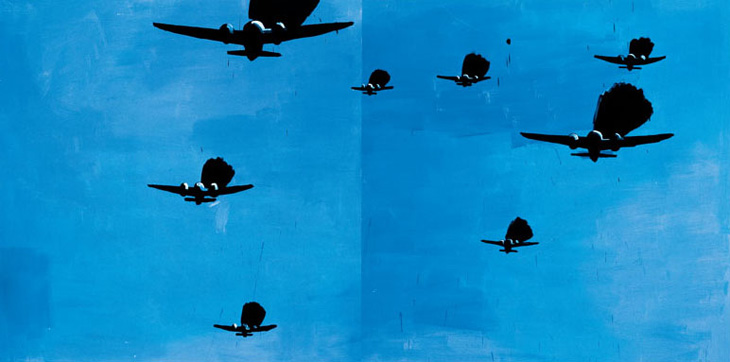
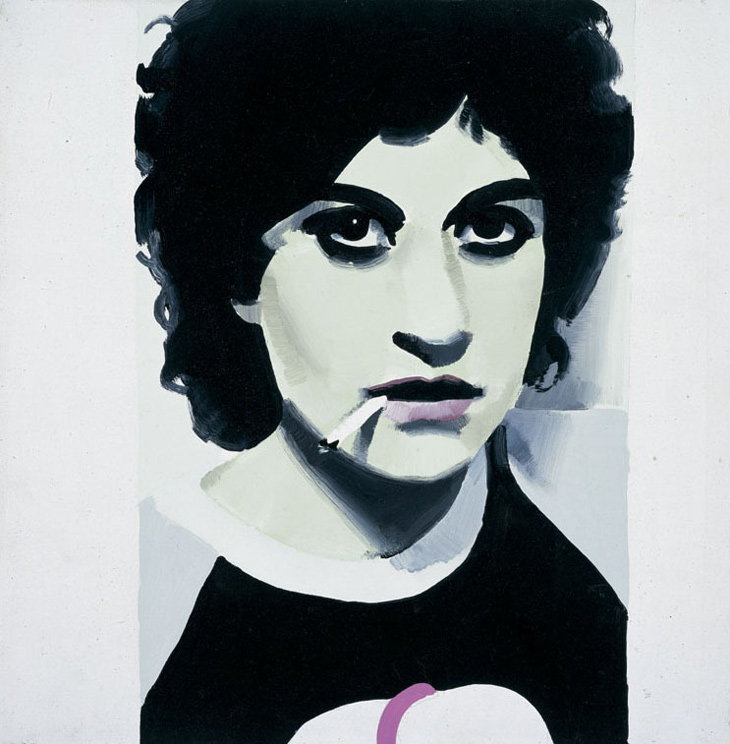
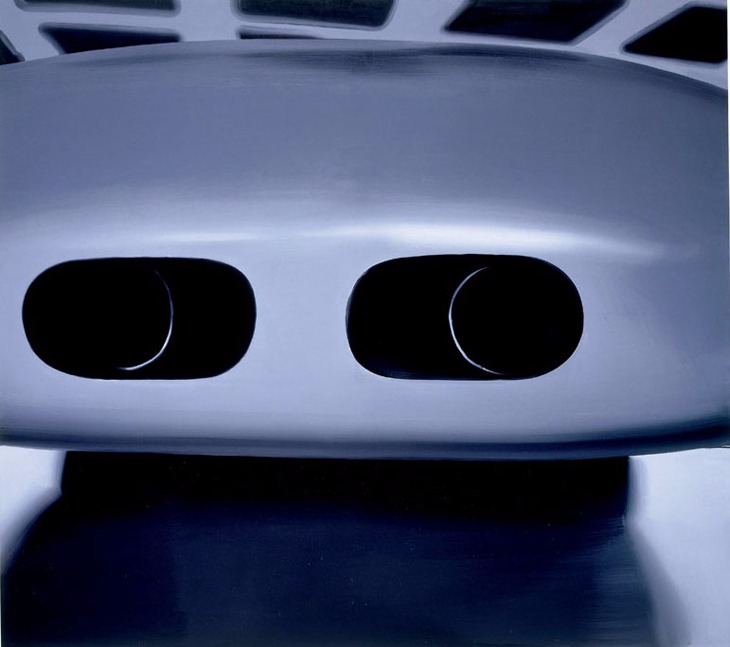
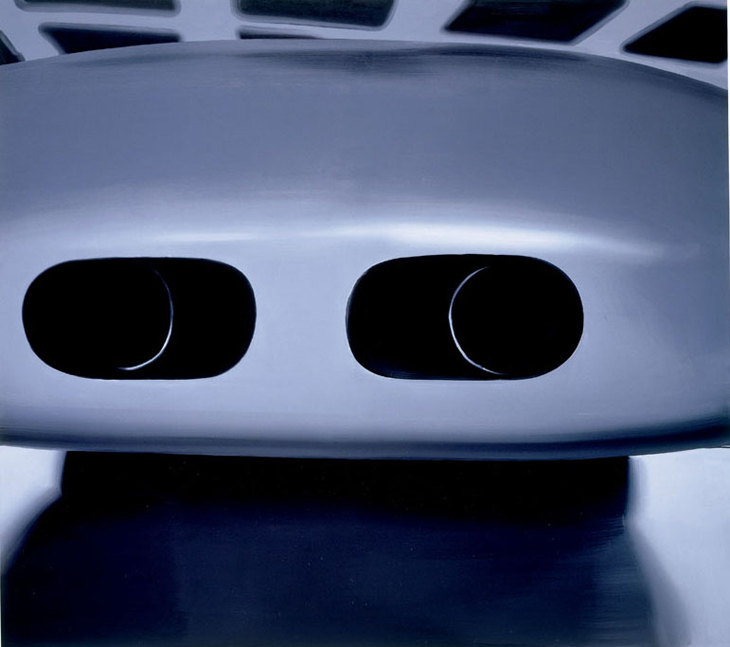
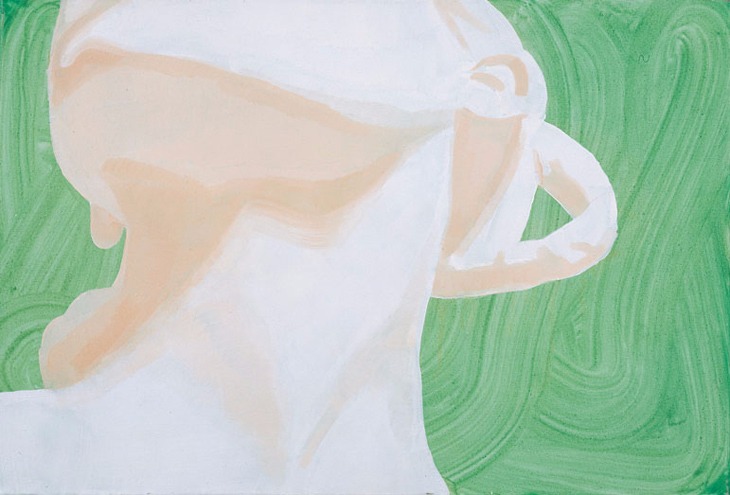
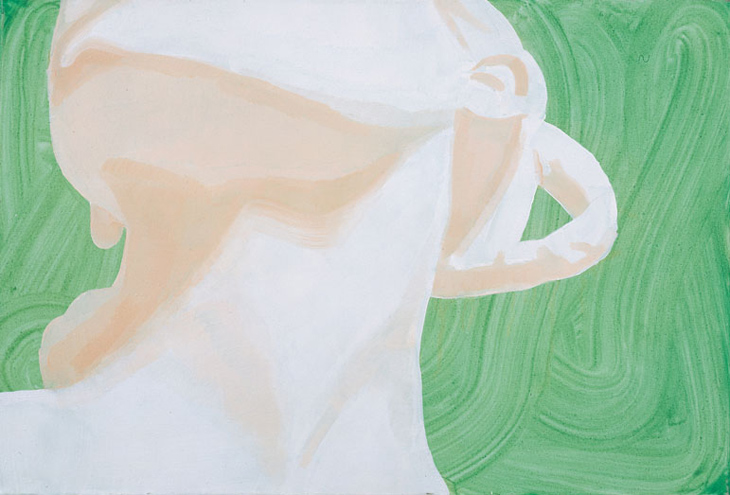
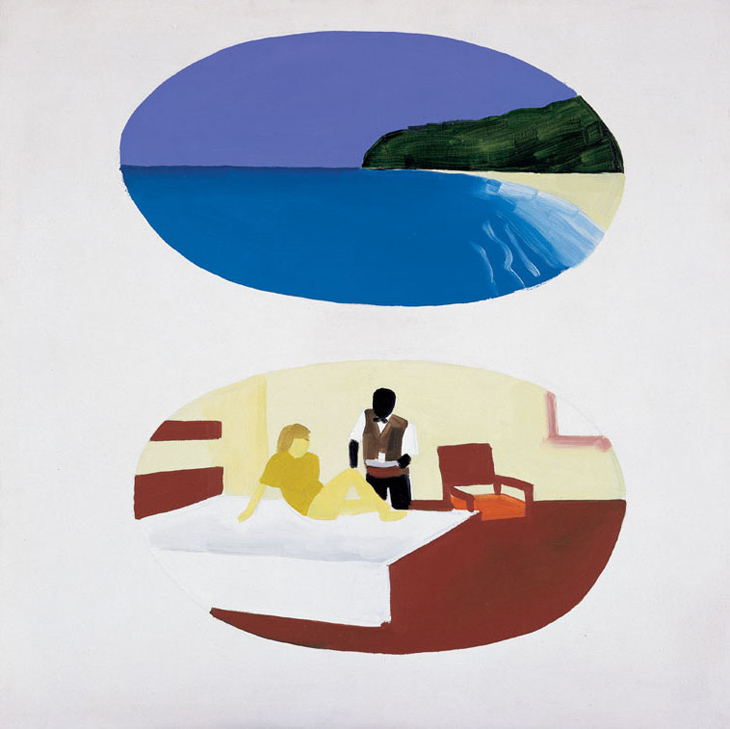
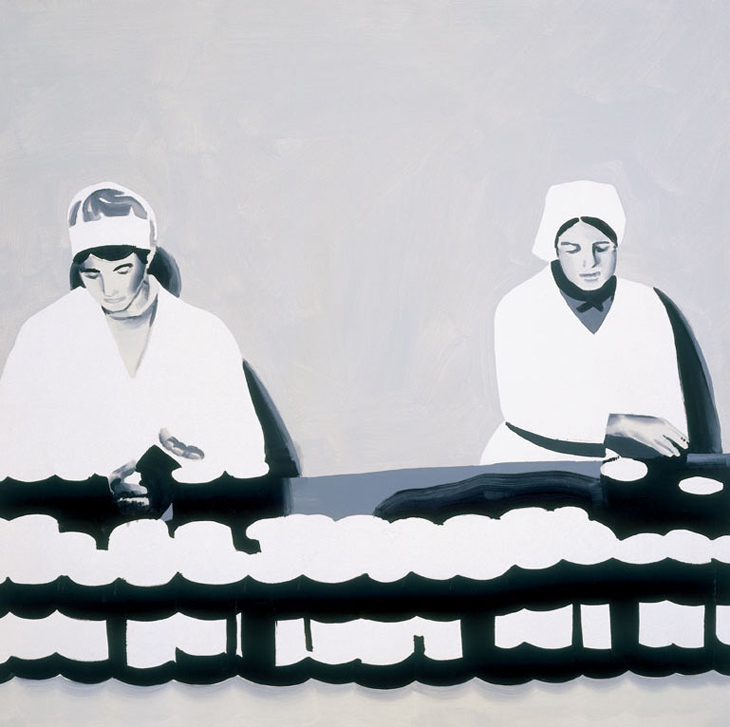
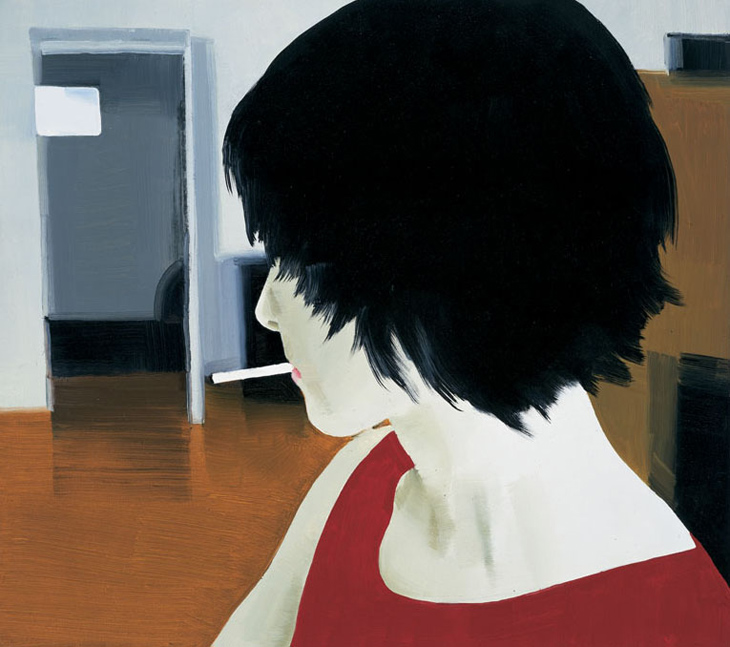
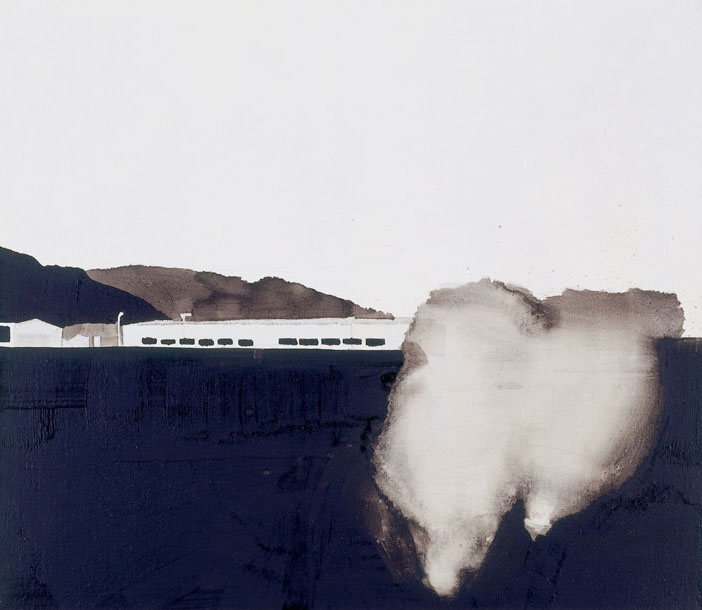
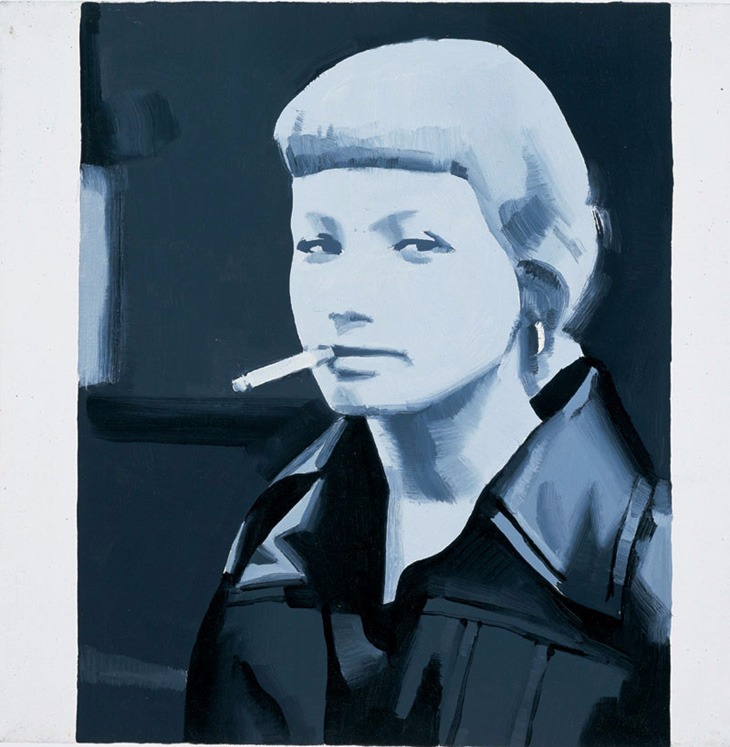
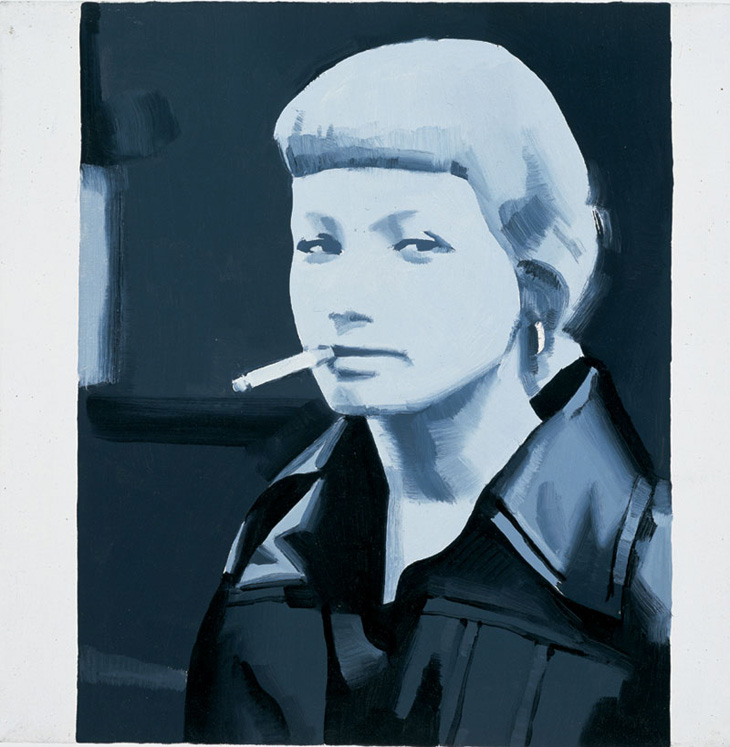
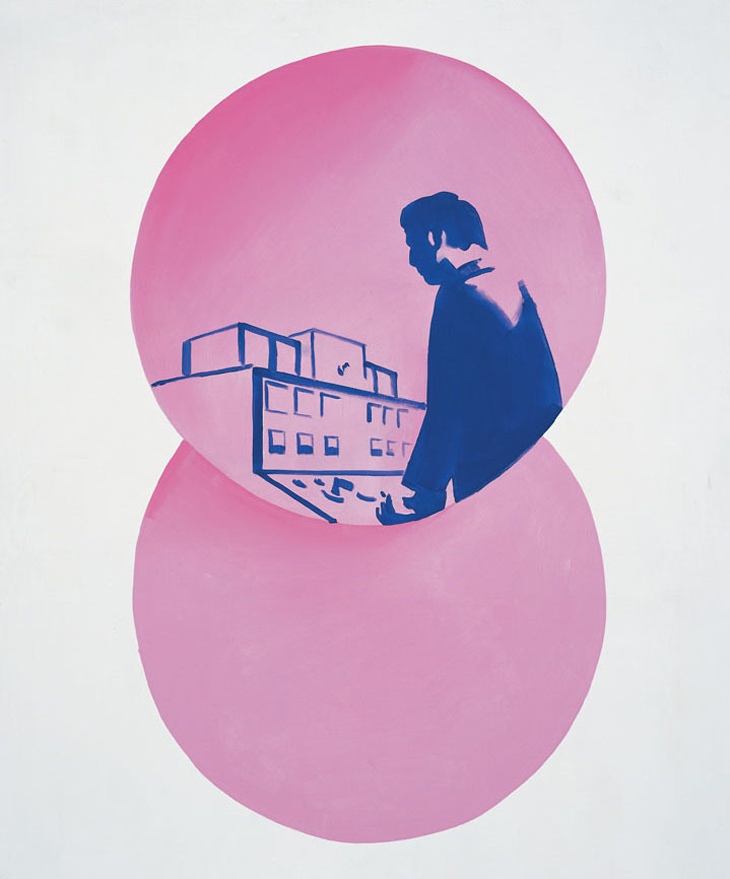
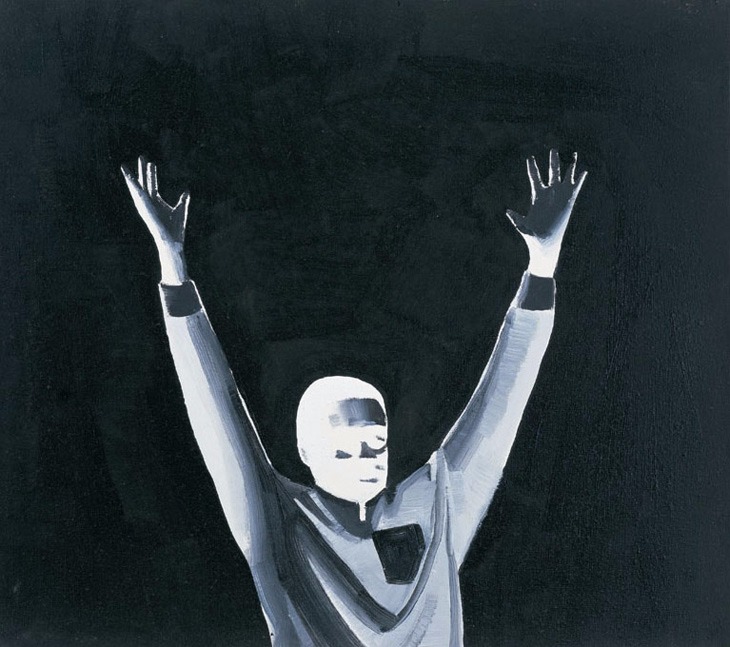
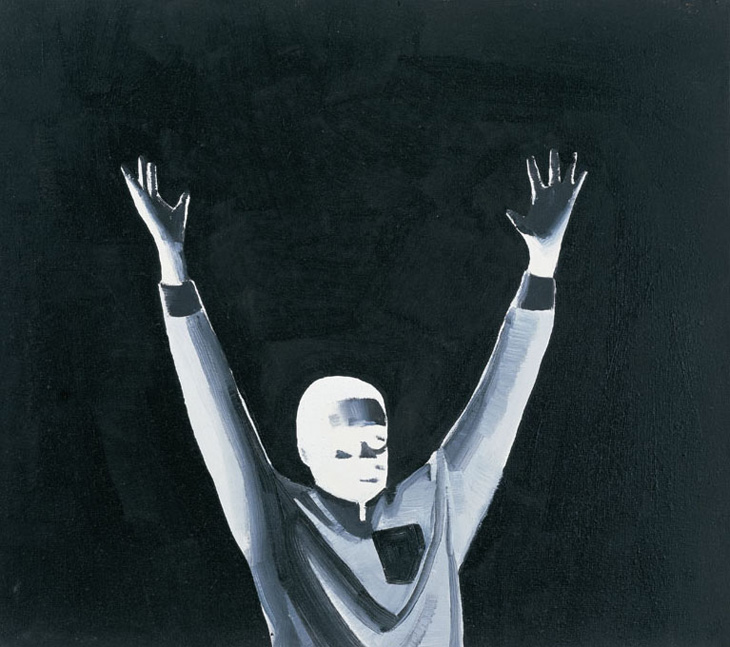

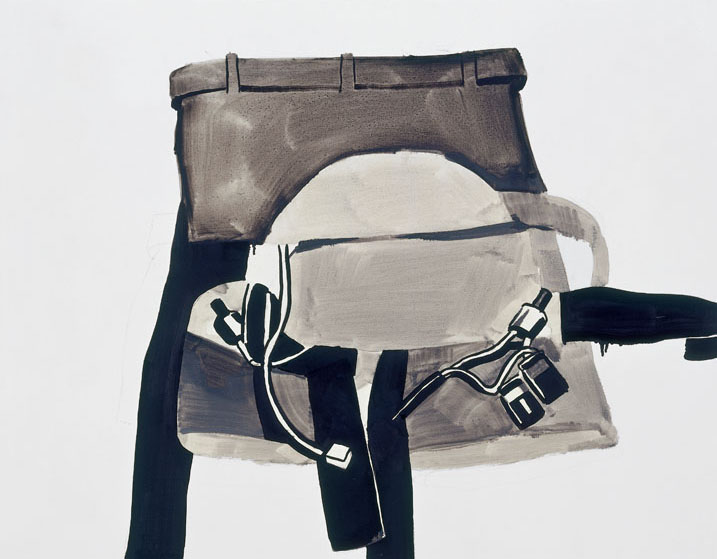
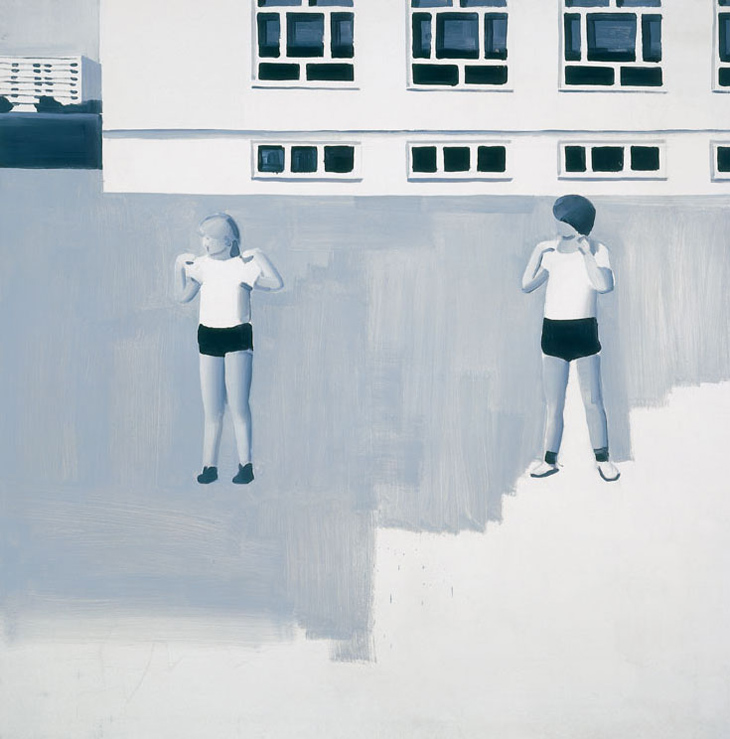
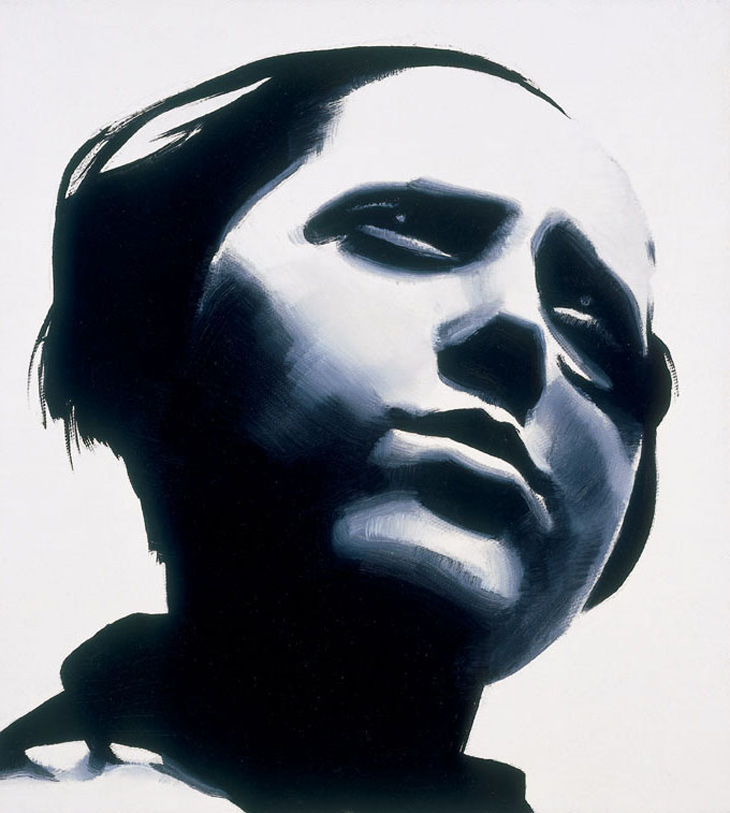
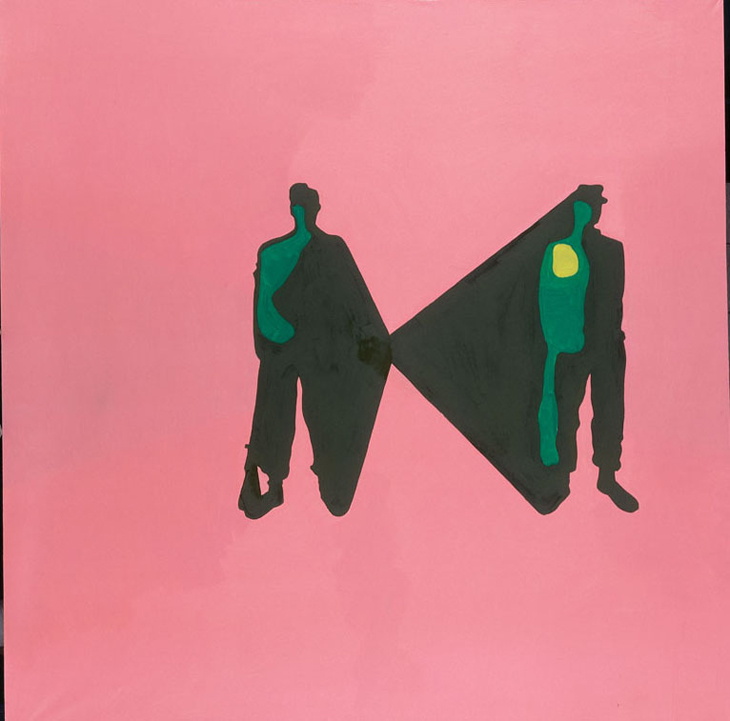
ARTIST:
Wilhelm Sasnal
Wilhelm Sasnal approaches painting as a formal exercise. He often borrows subjects from art history, 20th century propaganda, and photojournalism. Airplanes is a dark appropriation of Alighiero Boetti’s famous airplane drawings. Subverting the original pastoral optimism, Wilhelm Sasnal’s planes are engulfed in smoke as if they’ve been hit by enemy fire.
Wilhelm Sasnal deconstructs the hierarchy of ’high culture’ by filtering it through mass-media association. Through painting, Sasnal explores his own interpretation and understanding of imagery. His work constantly questions the space between ‘personal’ and ‘public’, and strives to define individual experience within a world order of collective consciousness. Flirting with the future, Wilhelm Sasnal’s space-age car is an unnervingly anthropomorphic vehicle promising a super determinism of technological prowess. Looming just beyond imagination, Car retains all its untold visual mystery; only a suggestive glimpse fits the canvas. It is not what the viewer sees that is important, but the disconcerting Orwellian sense that Car is looking back. Wilhelm Sasnal’s green lady is marbled perfection: a towering sculptural goddess executed as an anonymous product of design. Cropped, chin jutting out: her once symbolic mysticism now holds only graphic optimism, a pleasant hallmark of simplified form and bright colours. Wilhelm Sasnal repackages ideology for an indiscriminate consumer culture. Painting becomes a ritual of purification through aesthetics, which can sell even the most frightening of concepts. Sasnal presents the usual vacation ideals of sun, booze, and sex through a voyeuristic binocular view. Under surveillance scrutiny, the luxury resort emerges as something lonely, corrupt, and comically sad. Painted with a knowing faux naïveté, Resort is offered to all as an international logo/pictograph, loaded with overtures of condescension and imperialism. Painted from a famous propaganda image, Wilhelm Sasnal’s Factory swaps the celebratory ideal of the Socialist Worker for the impersonal hardness of mechanised production. Sasnal treats painting as a reductive process: information is lost in translation from photography to painting.
Using the original photo’s black-and-white tones, details are eradicated through heightened contrast, the image simplified through ‘overexposure’ and the intervention of the artist’s hand. Wilhelm Sasnal’s replicated images are dissociated from their once powerful meanings: they exist only as mere vestiges of themselves. Wilhelm Sasnal’s portraits of women explore modern concepts of beauty and representation. The pop star Peaches is given a degenerate Warhol glam; Anka, the alabaster sophistication of Katz. Dominika, painted in greyscale, has the allure of outdated photography suggestive of distinctively Eastern European chic.
Wilhelm Sasnal approaches feminine idealism as a construct of fashion. It’s not the physicality of the women themselves, but rather the style with which they’re represented. Each rendered in a manner associated with a specific time and place, Wilhelm Sasnal’s portraits aren’t classical icons, but models defined by their own sell-by dates. All pictured smoking a cigarette, Sasnal alludes to the slow self-destruction of their beauty. In Landscape, a row of Eastern European houses is half obliterated by a smoke bomb. In an image reminiscent of news clippings, Sasnal impersonalises the violence until it becomes nothing more than a perfect cloud. Dehumanised to the point of abstraction, Sasnal reduces horror to a mere formalist problem: a structural composition of terror; a self-absorbed contemplation of the sublime. Man at the Control Panel has the design of a government-issue poster. Through the act of painting, Wilhelm Sasnal divests this once authoritative image of any sense of infused power. It becomes merely an advertisement for banality, an explicit logo of its own defunct politics.
Through the personal intervention of making, Wilhelm Sasnal promotes a democratisation of image ownership. Through painting all things are rendered equal. Through rich and incongruous application techniques, Sasnal uses the paint itself to expose the paradoxical qualities of image interpretation. In Arms Raised, he subverts the documentary ‘truth’ of photography. Rendered in negative, his image of a champion becomes a hostage and heroicism is shrouded in a demonic aura. Sasnal exposes cultural triumph as conspiracy, inherently underscored with apocalyptic sensations of revulsion and fear. Sasnal draws his subject matter from day-to-day reality. The most banal examples of still life mingle with commensurate importance to propaganda icons, advertising, and photojournalistic imagery.
An ambiguous Tuymans-like rendering of a suicide bomber’s belt/parachute/life jacket is painted with the impartiality of an instruction-manual illustration. Terrorist Equipment is dissociated from any political meaning, rendered inconsequential in the cold vernacular of documentation. Gym Lesson offers a colourless documentation of children at play, reminiscent of Soviet social painting stripped of all joyous idealism. Emptying the image of vivacious allure, Sasnal’s painting operates as palimpsest: through its impartial and sterile surface, only faint traces of historical significance remain. For Wilhelm Sasnal, painting is imperative as a means to challenge traditional expectations of representation and perception. Through the personal intervention of making, his subject matter becomes distorted. Images are pared down to their barest essentials and estranged from their original context and meaning.
Portrait of Rodchenko, Lady resurrects the photographer’s iconic image. Gone is her golden Soviet virtue, replaced by a fiercely dark shadow. Wilhelm Sasnal’s reconstruction is a hollow memento, a death mask of a graven image. Sasnal’s soldiers are reduced to a kitsch logo: war, oppression, and authority are reconstituted as youth culture communismo-chic. Rendered as pure pop, Soldiers wittingly adopts an amoral capitalist ethic, where authoritarianism and violence are reconstituted as retro cool. Sasnal’s paintings don’t celebrate freedom, but rather a shift in media-dictated conformity.
Wilhelm Sasnal deconstructs the hierarchy of ’high culture’ by filtering it through mass-media association. Through painting, Sasnal explores his own interpretation and understanding of imagery. His work constantly questions the space between ‘personal’ and ‘public’, and strives to define individual experience within a world order of collective consciousness. Flirting with the future, Wilhelm Sasnal’s space-age car is an unnervingly anthropomorphic vehicle promising a super determinism of technological prowess. Looming just beyond imagination, Car retains all its untold visual mystery; only a suggestive glimpse fits the canvas. It is not what the viewer sees that is important, but the disconcerting Orwellian sense that Car is looking back. Wilhelm Sasnal’s green lady is marbled perfection: a towering sculptural goddess executed as an anonymous product of design. Cropped, chin jutting out: her once symbolic mysticism now holds only graphic optimism, a pleasant hallmark of simplified form and bright colours. Wilhelm Sasnal repackages ideology for an indiscriminate consumer culture. Painting becomes a ritual of purification through aesthetics, which can sell even the most frightening of concepts. Sasnal presents the usual vacation ideals of sun, booze, and sex through a voyeuristic binocular view. Under surveillance scrutiny, the luxury resort emerges as something lonely, corrupt, and comically sad. Painted with a knowing faux naïveté, Resort is offered to all as an international logo/pictograph, loaded with overtures of condescension and imperialism. Painted from a famous propaganda image, Wilhelm Sasnal’s Factory swaps the celebratory ideal of the Socialist Worker for the impersonal hardness of mechanised production. Sasnal treats painting as a reductive process: information is lost in translation from photography to painting.
Using the original photo’s black-and-white tones, details are eradicated through heightened contrast, the image simplified through ‘overexposure’ and the intervention of the artist’s hand. Wilhelm Sasnal’s replicated images are dissociated from their once powerful meanings: they exist only as mere vestiges of themselves. Wilhelm Sasnal’s portraits of women explore modern concepts of beauty and representation. The pop star Peaches is given a degenerate Warhol glam; Anka, the alabaster sophistication of Katz. Dominika, painted in greyscale, has the allure of outdated photography suggestive of distinctively Eastern European chic.
Wilhelm Sasnal approaches feminine idealism as a construct of fashion. It’s not the physicality of the women themselves, but rather the style with which they’re represented. Each rendered in a manner associated with a specific time and place, Wilhelm Sasnal’s portraits aren’t classical icons, but models defined by their own sell-by dates. All pictured smoking a cigarette, Sasnal alludes to the slow self-destruction of their beauty. In Landscape, a row of Eastern European houses is half obliterated by a smoke bomb. In an image reminiscent of news clippings, Sasnal impersonalises the violence until it becomes nothing more than a perfect cloud. Dehumanised to the point of abstraction, Sasnal reduces horror to a mere formalist problem: a structural composition of terror; a self-absorbed contemplation of the sublime. Man at the Control Panel has the design of a government-issue poster. Through the act of painting, Wilhelm Sasnal divests this once authoritative image of any sense of infused power. It becomes merely an advertisement for banality, an explicit logo of its own defunct politics.
Through the personal intervention of making, Wilhelm Sasnal promotes a democratisation of image ownership. Through painting all things are rendered equal. Through rich and incongruous application techniques, Sasnal uses the paint itself to expose the paradoxical qualities of image interpretation. In Arms Raised, he subverts the documentary ‘truth’ of photography. Rendered in negative, his image of a champion becomes a hostage and heroicism is shrouded in a demonic aura. Sasnal exposes cultural triumph as conspiracy, inherently underscored with apocalyptic sensations of revulsion and fear. Sasnal draws his subject matter from day-to-day reality. The most banal examples of still life mingle with commensurate importance to propaganda icons, advertising, and photojournalistic imagery.
An ambiguous Tuymans-like rendering of a suicide bomber’s belt/parachute/life jacket is painted with the impartiality of an instruction-manual illustration. Terrorist Equipment is dissociated from any political meaning, rendered inconsequential in the cold vernacular of documentation. Gym Lesson offers a colourless documentation of children at play, reminiscent of Soviet social painting stripped of all joyous idealism. Emptying the image of vivacious allure, Sasnal’s painting operates as palimpsest: through its impartial and sterile surface, only faint traces of historical significance remain. For Wilhelm Sasnal, painting is imperative as a means to challenge traditional expectations of representation and perception. Through the personal intervention of making, his subject matter becomes distorted. Images are pared down to their barest essentials and estranged from their original context and meaning.
Portrait of Rodchenko, Lady resurrects the photographer’s iconic image. Gone is her golden Soviet virtue, replaced by a fiercely dark shadow. Wilhelm Sasnal’s reconstruction is a hollow memento, a death mask of a graven image. Sasnal’s soldiers are reduced to a kitsch logo: war, oppression, and authority are reconstituted as youth culture communismo-chic. Rendered as pure pop, Soldiers wittingly adopts an amoral capitalist ethic, where authoritarianism and violence are reconstituted as retro cool. Sasnal’s paintings don’t celebrate freedom, but rather a shift in media-dictated conformity.




















